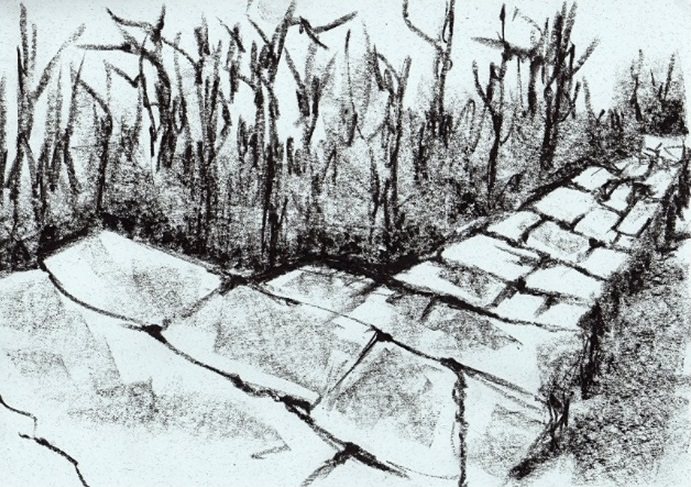
The great wall of China
I love you, o late sad, o late augusta, who, between
The first flashes of the stars, in the womb,
Under the veils of mystery and shadow in the dew.
Bring the throb, as a result of the fall,
The night, soul nurturer of lust and sleeping,
Perpetuation of life and initiation of nowhere…
(BILAC, 1997, p. 61)
Step by step 10 of how to draw
One of the wonders of the world, to Great wall of China It is also a work of art and architecture. Its construction began around 220 B.C.. and lasted for more than 1500 years, going through several dynasties and using manpower, workers, slaves, soldiers and peasants. With more than 7 1000 km long, its structure was made in several steps, in keeping with the rugged relief and with the different materials available in each region. In its vast expanse, were made for surveillance towers, doors and strong, in order to protect China from raids. Currently, the great wall is a Unesco World Heritage site and is the symbol of China.

This construct is an inspirational work of art, just beautiful, by itself, but I can imagine this greatness, in the midst of a sunset. I chose so Orange, between the colors in the afternoon, and did my interpretation of the wall, in drawing form, painting just with the pencil Brown, stylized medium. Basis weight 140, with A4 size, with texture, my role was already part of the scene, with the color of a sunset.

Taking as a starting point the Tower, in the air, my scene went down winding walls and staircases, as if to accompany the rises and falls of the mountains of the region. For this, It took some studies of vanishing point, straight and curved, with and without stairs, in separate sheet, What helped in the production of the work. There are still, on the wall, staircases and walls with different thicknesses, by virtue of its own construction, at different times and with diverse materials. The vanishing point, here, applied correctly when drawing, that's what provided the final effect of volume. The thickness of the walls must also accompany the prospect, and decrease towards the vanishing point.

For the walls and the Tower stayed with old aspect, I sought to reinforce with brown color, in the corners, in the upper and lower parts alternately, bringing naturalness to the scene. To get the effect of a little overcast sky, I worked with a slight darkening at the bottom of the clouds. The bushes and the trees around the Walls were made of very simple, with short risk, from bottom to top, imitating leaves and trunks of trees.

And the look is lost amid the maze of walkways and stairs of one of the great works that the human being built. Maybe one day I can visit the great wall, but until that occurs, the art takes me to her.
We will try to reproduce the great wall, with different colors?
Check out the video of the production of the great wall:
…
Sign up to receive Event News
and the Universe of Arts first!
Liked? [highlight]Leave a comment[/highlight]!
You might also like:
- Painting on Canvas, Step by step 18 – Perception of colors and shapes by Rosângela Vig
- Design – Artistic Production, Step by step 17 of how to draw by Rosângela Vig
- Drawing – Painting on Canvas, Step by step 16 of how to draw by Rosângela Vig
- Design – Study of the Form, Step by step 15 of how to draw by Rosângela Vig
- Design – Artistic Production, Step by step 14 of how to draw by Rosângela Vig
- Design – Artistic Production, Step by step 13 of how to draw by Rosângela Vig
- Design – Artistic Production, Step by step 12 of how to draw by Rosângela Vig
- Design – Artistic Production, Step by step 11 of how to draw by Rosângela Vig
- Design – Artistic Production, Step by step 9 of how to draw by Rosângela Vig
- Design – Artistic Production, Step by step 8 of how to draw by Rosângela Vig
- Design – Artistic Production, Step by step 7 of how to draw by Rosângela Vig
- Design – Artistic Production, Step by step 6 of how to draw by Rosângela Vig
- Drawing and Painting – The Abstract, Step by step 5 of how to draw by Rosângela Vig
- Drawing – Movement, Step by step 4 of how to draw by Rosângela Vig
- Drawing – Study of Colors, Step by step 3 of how to draw by Rosângela Vig
- Drawing – Study of Light and Shadow, Step by step 2 of how to draw by Rosângela Vig
- Drawing – Study of Perspective, Step by step 1 of how to draw by Rosângela Vig
Articles about the Art History of Rosângela Vig:
References:
- BILAC, Olavo. Antologia Poética. Porto Alegre: L&PM Editores, 1997.
The figures:
Fig. 1 – Ready drawing of the great wall, Rosângela Vig.
Fig. 2 – Training of vanishing point of the great wall, with straight wall, Rosângela Vig.
Fig. 3 – The Great Wall, painted design, Rosângela Vig.
Fig. 4 – The Great Wall, painted design, Re-reading, Rosângela Vig.
ROSÂNGELA VIG
Sorocaba – São Paulo
Facebook Profile | Facebook Fan Page | Website
Columnist at Website Obras de Arte
E-mail: rosangelavig@hotmail.com
